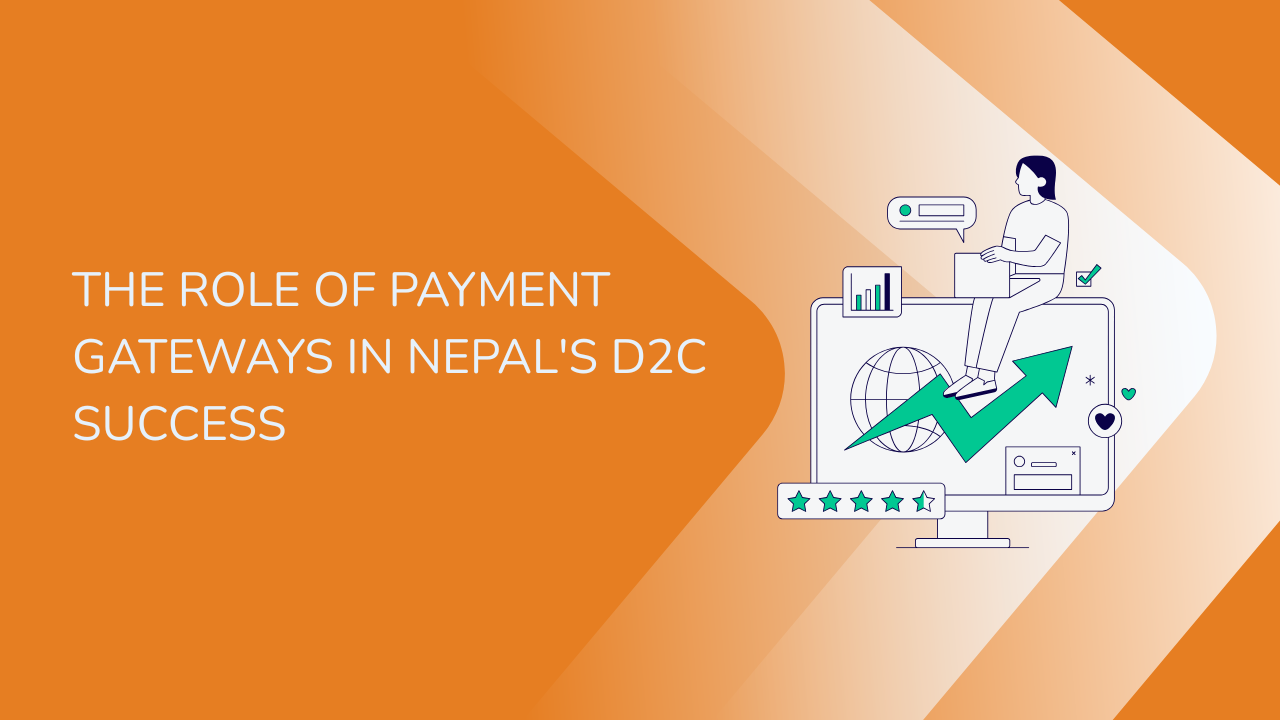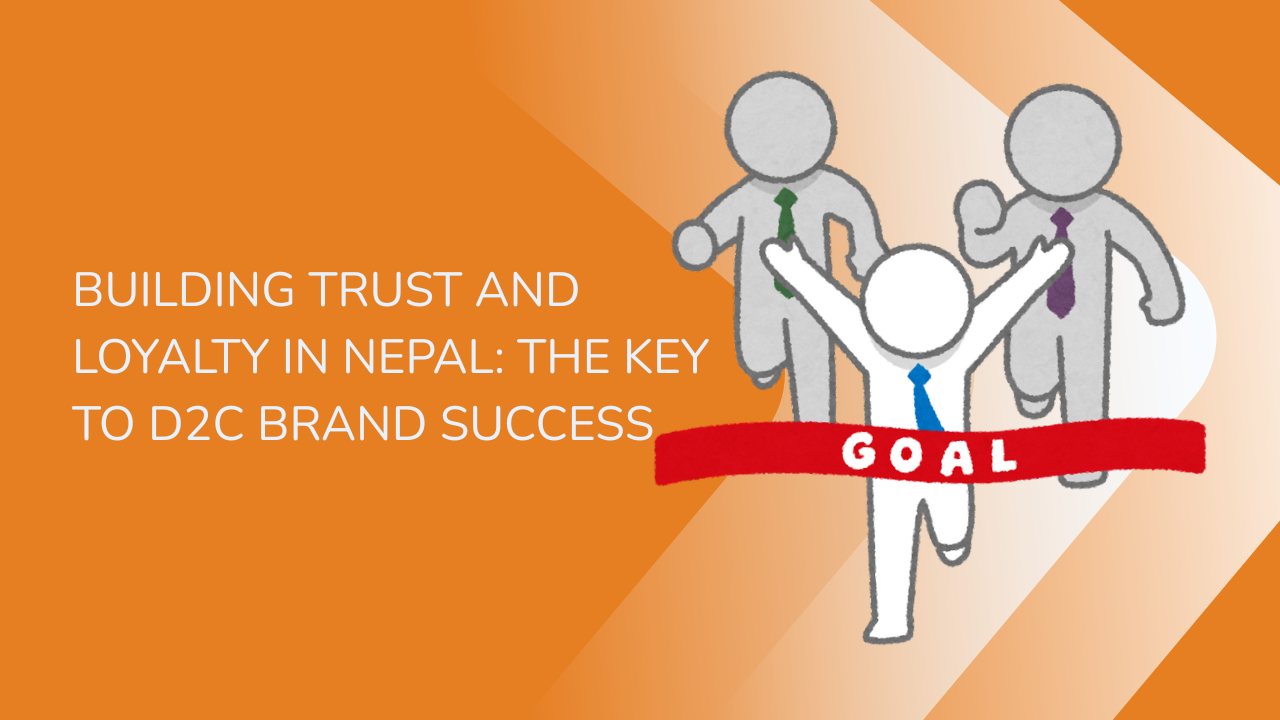Share this Article
The rise of Direct-to-Consumer (D2C) businesses in Nepal has significantly transformed the e-commerce landscape. As these businesses focus on providing products and services directly to consumers, one of the most crucial aspects of their success is the ability to offer a reliable and secure payment system. Payment gateways have become the backbone of the digital economy, enabling smooth, safe, and efficient transactions. For D2C businesses, understanding and integrating the right payment systems is essential to fostering consumer trust, streamlining operations, and driving growth.
As Nepal's internet and mobile usage continue to increase, the role of payment gateways in enabling D2C businesses to thrive becomes more prominent. With the rising demand for online shopping, having a seamless, secure, and user-friendly payment process is critical for success. In this blog, we will explore how payment gateways impact D2C businesses in Nepal, how they contribute to building trust with consumers, and how businesses can capitalize on this crucial technology to improve their operations and scale effectively.
1. Understanding Payment Gateways and Their Significance
A payment gateway is an essential technology that facilitates electronic transactions between consumers and businesses. It acts as the intermediary that processes payment information securely between the buyer, the seller, and the financial institutions involved. When a consumer makes an online purchase, the payment gateway verifies the transaction, authorizes the payment, and ensures that the money is transferred to the merchant’s account.
For D2C businesses in Nepal, payment gateways serve as a vital tool for ensuring a smooth transaction process, reducing transaction friction, and increasing the overall efficiency of their e-commerce operations. A reliable payment system not only streamlines operations but also provides customers with the confidence to make online purchases. With the ever-expanding e-commerce landscape, ensuring that D2C businesses are using efficient and secure payment gateways is key to building a strong online presence and improving conversion rates.
2. The Role of Payment Gateways in Building Consumer Trust
One of the primary barriers to online shopping in Nepal has been the hesitation of consumers to share sensitive payment information due to concerns about security. In many cases, the lack of trust in the security of online payment systems has led to cart abandonment, where consumers add items to their carts but are unwilling to complete the transaction.
For D2C businesses, building trust through secure payment systems is essential. Payment gateways help instill confidence in consumers by offering robust security features, including encryption protocols and fraud prevention measures. A secure payment process not only protects customer data but also reassures consumers that their financial information is safe. As a result, they are more likely to complete transactions, resulting in higher conversion rates and increased sales.
Key Aspects of Secure Payment Gateways:
- Data Encryption and Protection:
Reputable payment gateways use advanced encryption technologies, such as Secure Socket Layer (SSL) encryption, to protect sensitive customer data during the transaction process. This ensures that payment information, such as credit card details and personal data, is securely transmitted between the customer and the merchant. By using payment gateways that employ strong encryption standards, D2C businesses can safeguard their customers’ information, which is crucial for building long-term trust and loyalty.
- Compliance with Global Security Standards:
Most reliable payment gateways adhere to international security standards, such as the Payment Card Industry Data Security Standard (PCI DSS). These standards provide guidelines for ensuring that payment systems handle customer data securely. For D2C brands in Nepal, choosing a payment gateway that complies with these standards is essential for ensuring that they meet global security requirements and maintain consumer confidence.
- Fraud Detection and Prevention:
Payment gateways also offer fraud detection mechanisms, which are designed to monitor transactions for suspicious activity. If a payment appears fraudulent, the gateway can flag the transaction, reducing the risk of chargebacks and financial loss for the business. By integrating payment systems with robust fraud protection features, D2C businesses can further reassure their customers that their payment information is being handled securely.
3. Offering Multiple Payment Methods for Consumer Convenience
In Nepal, the diversity of payment preferences among consumers is significant, especially as mobile and digital payment systems gain traction. While credit and debit cards are still widely used, mobile wallets and other digital payment methods are increasingly becoming the preferred payment option for many consumers. Mobile wallets, such as eSewa, Khalti, IME Pay, and Fonepay, have become widely accepted in Nepal and are frequently used for online transactions due to their ease of use and convenience.
To meet the needs of a diverse customer base, D2C businesses must offer a range of payment options. Payment gateways that provide various payment methods, such as credit/debit cards, mobile wallets, digital banking, and Cash on Delivery (COD), enable D2C brands to cater to different consumer preferences, boosting customer satisfaction and increasing the likelihood of successful transactions.
Importance of Mobile Payment Systems:
- The Rise of Mobile Wallets:
With the increasing use of smartphones in Nepal, mobile wallets have become a popular alternative to traditional banking. These wallets allow consumers to store money digitally and make payments quickly and securely. By integrating payment gateways that support popular mobile wallets, D2C businesses can offer a seamless, quick, and convenient payment experience to customers, especially in urban areas where mobile payments are widely used.
- Bank Transfers and Credit/Debit Cards:
While mobile wallets are gaining popularity, many consumers in Nepal still prefer traditional payment methods, such as credit/debit cards or direct bank transfers. Payment gateways that accept these forms of payment ensure that D2C businesses can reach a wide customer base and cater to those who prefer these more conventional methods. Moreover, ensuring that bank transfers are supported can help D2C businesses expand their reach to customers who may not use mobile wallets but are comfortable with direct payments.
- Cash on Delivery (COD):
Cash on Delivery is still a preferred payment method for many Nepali consumers, especially in rural areas where digital payment systems are not yet fully adopted. By offering COD as an option, D2C brands can make their products more accessible to customers who are hesitant to pay online. Many payment gateways in Nepal support COD, enabling businesses to offer flexibility in payment methods while still securing the transaction process.
4. Payment Gateways: Streamlining Operations and Reducing Transaction Friction
For D2C brands, having a smooth and efficient payment process is essential to keeping operations running smoothly. Payment gateways are not only important for processing payments but also for improving overall business efficiency by automating tasks like payment reconciliation, reporting, and invoicing. By automating these processes, payment gateways reduce administrative burdens and allow D2C businesses to focus on scaling their operations.
Payment gateways also reduce transaction friction, which refers to the obstacles that may cause customers to abandon their purchases before completing the transaction. This friction can come from slow payment processing times, complicated checkout processes, or security concerns. By providing a fast and secure payment system, D2C brands can increase the likelihood that customers will complete their purchases, improving conversion rates and enhancing the overall customer experience.
Benefits of Streamlined Payment Systems:
- Real-Time Payment Processing:
One of the key advantages of modern payment gateways is the ability to process payments in real-time. This means that once a customer makes a payment, the transaction is immediately verified and confirmed. Real-time payment processing ensures that D2C brands can quickly fulfill orders, improving delivery times and customer satisfaction. Additionally, faster payment processing leads to fewer delays, which is especially important when consumers expect quick service in today's fast-paced e-commerce environment.
- Reducing Cart Abandonment:
One of the most significant challenges faced by D2C brands is cart abandonment. Customers may add items to their shopping carts but fail to complete the checkout process due to a slow or complicated payment system. Payment gateways that offer a seamless, quick, and user-friendly payment process help reduce cart abandonment rates, leading to higher conversion rates. By simplifying the payment process and minimizing friction at checkout, D2C businesses can encourage customers to follow through with their purchases.
- Automating Payment Reconciliation and Reporting:
Payment gateways also automate payment reconciliation, making it easier for businesses to track their financial transactions. This eliminates the need for manual record-keeping and ensures that payment data is accurate and up to date. By streamlining financial reporting, payment gateways help D2C businesses maintain clear and transparent accounting practices, which is vital for tracking revenue, managing expenses, and ensuring financial stability.
5. Overcoming Challenges in Nepal’s Payment Landscape
Despite the rapid adoption of digital payments in Nepal, challenges remain, particularly in rural areas where internet access and mobile penetration are still limited. For D2C businesses looking to expand their reach across the country, it’s important to consider these challenges when selecting payment gateways. Payment systems that work effectively in urban areas may face issues in rural regions, where connectivity and digital literacy may not be as high.
Moreover, many consumers in Nepal still prefer using Cash on Delivery (COD) over online payment methods due to concerns about security and the unfamiliarity with digital payments. As such, offering a variety of payment options is key for D2C businesses looking to cater to diverse customer needs.
Addressing Connectivity Issues:
- Ensuring Access in Low-Connectivity Areas:
Payment gateways need to be designed to function efficiently even in areas with limited internet connectivity. For D2C businesses aiming to reach rural consumers, ensuring that their payment systems are optimized for low-bandwidth environments can make a significant difference. Some payment systems have offline capabilities, allowing transactions to be processed when internet access is restored. By adopting such solutions, D2C businesses can ensure that consumers in remote areas can still make payments easily and securely.
Educating Consumers About Digital Payments:
- Increasing Digital Literacy:
To overcome the hesitations surrounding digital payments, D2C brands can play an active role in educating consumers about the benefits of using secure online payment systems. By providing clear instructions on how to use payment gateways, offering customer support, and promoting the safety features of digital payments, businesses can help customers feel more confident in using online payment systems. This education can ultimately increase the adoption of digital payments across a wider customer base.
Conclusion: Empowering D2C Brands with Robust Payment Gateways
In Nepal’s rapidly evolving e-commerce landscape, payment gateways play a central role in the success of D2C businesses. They provide the security, convenience, and flexibility needed to foster consumer trust, enhance the shopping experience, and streamline business operations. As mobile wallets and digital payment methods gain popularity, the ability to offer multiple payment options is crucial for reaching a diverse customer base and driving growth.
By adopting reliable and secure payment systems, D2C businesses can build stronger relationships with their customers, reduce friction in the checkout process, and scale effectively in Nepal’s growing digital economy. Investing in the right payment gateways is not just about processing transactions – it’s about creating a seamless, safe, and efficient online shopping experience that keeps customers coming back and encourages long-term loyalty.
As digital payments continue to evolve, D2C brands that embrace these changes and integrate them into their payment infrastructure will be best positioned to succeed in Nepal's rapidly expanding e-commerce market.
Categories:
Success Stories & Case Studies
Tags:
E-commerce







